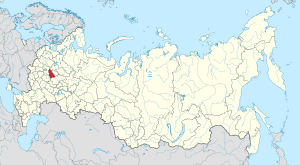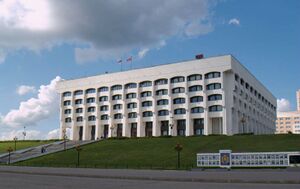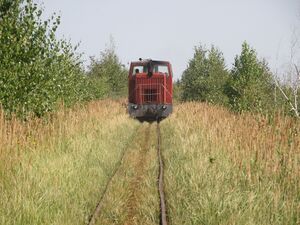أوبلاست ڤلاديمير
Vladimir Oblast | |
|---|---|
| Владимирская область | |
 | |
 | |
| الإحداثيات: 56°05′N 40°37′E / 56.083°N 40.617°E | |
| البلد | روسيا |
| المنطقة الاتحادية | Central[1] |
| المنطقة الاقتصادية | Central[2] |
| تأسست | August 14, 1944[3] |
| Administrative center | Vladimir[4] |
| الحكومة | |
| • الكيان | Legislative Assembly[5] |
| • Acting Governor[5] | Aleksandr Avdeyev (United Russia) |
| المساحة | |
| • Total | 29٬000 كم² (11٬000 ميل²) |
| ترتيب المساحة | 66th |
| التعداد (2010 Census)[7] | |
| • Total | 1٬443٬693 |
| • Estimate (2018) | 1٬378٬337 (−4٫5%) |
| • الترتيب | 31st |
| • الكثافة | 50/km2 (130/sq mi) |
| • Urban | 77٫6% |
| • الريف | 22٫4% |
| منطقة التوقيت | UTC+3 (توقيت موسكو |
| ISO 3166 code | RU-VLA |
| لوحات السيارات | 33 |
| OKTMO ID | 17000000 |
| اللغات الرسمية | الروسية[9] |
| الموقع الإلكتروني | http://www.avo.ru |
أوبلاست ڤلاديمير (روسية: Влади́мирская о́бласть؛ Vladimirskaya oblast) هي إحدى الكيانات الفدرالية في روسيا. Its administrative center is the city of Vladimir, which is located 190 كيلومتر (120 mi) east of Moscow. As of the 2010 Census, the oblast's population was 1,443,693.[7]
The UNESCO World Heritage List includes the 12th-century cathedrals of Vladimir, Suzdal, Bogolyubovo, and Kideksha.
الجغرافيا
Vladimir Oblast borders Moscow, Yaroslavl, Ivanovo, Ryazan, and Nizhny Novgorod Oblasts. The oblast is situated in the center of the East European Plain. The Klyazma and the Oka are the most important rivers. There are approximately three hundred lakes. The oblast is situated in a zone of mixed forests.
الوحيش
The oblast's fauna currently includes more than fifty species of mammals (some examples including elk, wild boar, roe deer, red and sika deer, lynx, wolf, squirrel, rabbit, marten, fox, weasel, badger and other fur-bearing animals), five species of reptiles, and ten species of amphibians. The semiaquatic Russian desman is listed in the Russian Red Book of endangered species. The region is inhabited by 216 species of birds, among which are the capercaillie, black grouse, grouse, partridge, woodcock, goose, duck, etc. The lesser white-fronted goose is listed in the Red Book.
Hunting season runs from October to February with the following license and permit restrictions:
- Elk, wild boar, red deer, and sika deer from mid-November through mid-January
- Hare from October through January
- Grouse, black grouse, woodcock, duck and goose for 10 days in April.
Bodies of water in the region are rich in numerous species (about 40) of fresh-water fish (e.g. eel, roach, pike, perch, bream, rudd, and sturgeon in the Klyazma River), which support ice fishing in winter. Additionally, the oblast has several hunting farms.
الهيدروگرافيا
The total expanse of the oblast's surface waters is 32.9 hectares.
The region has hundreds of rivers with a total length of more than 8.6 million kilometers—there are 560 rivers and streams throughout the oblast. The Klyazma River flows into the Oka River on the south-eastern edge of the oblast's border with the Nizhny Novgorod Region. The Klyazma River's major tributaries in the Vladimir Region are the Sherna (with the Molokcha flowing into it), the Kirzhach (with its own tributaries being the Big and Small Kirzhach), the Peksha, the Koloksha, the Nerl, the Sudogda, the Uvod, the Lukh and the Suvorosch. Tributaries of the Oka within Vladimir oblast are the Gus, Unzha, and Ushna rivers. The Dubna River, a tributary of the Volga River, originates near the town of Alexandrov. The Oka River is navigable throughout the region (157 km). The rivers in the region are characterized by their flat currents, broad valleys and meandering channels. Water levels are characterized by their high spring tides, low water periods over summer-autumn with occasional flooding during heavy rains, and stable/low levels throughout the winter.
There are about three hundred lakes covering an area of five thousand hectares. Most of them are small and undrained and many are overgrown with a peat layer. The origin of the lakes varies. Numerous oxbow lakes are scattered along the river valleys. The largest of them are Lake Urvanovskoe (12 km long) and Lake Visha (length about 10 km). In the Meshchera Lowlands and in the northwest of the oblast are lakes of ancient alluvial valleys: Isikhry, Svyatoe and others. Lakes of karst origin, located in the lower reaches of the Klyazma and in the center of Vyaznikovsky District (a northeastern district in the oblast), have highly mineralized water and are associated with underground watercourses. The largest and deepest of them is Lake Kshchara. In the districts of Alexandrov and Yuryev-Polsky glacial lakes are small in size.
The main masses of wetlands in the region (total area of 37.4 thousand hectares ) occur in Meshchera and Balakhna (in the northeast of the oblast) lowlands.
التاريخ
The territory of modern Vladimir Oblast has been populated since ancient times. The oldest known traces of human settlement date to the Upper Paleolithic. A settlement of Homo Sapiens dating back to 25,000 BCE was discovered in the area of Sungir. The region of Vladimir were inhabited by different people like Slavs, Tatars, Finno-Ugrics and Balts. The East Slavic tribe of the Buzhans originated in the Vladimir region. Archaeological excavations of Volga Finn settlements document also the Finno-Ugric roots of this land. Merya, Muromian, and Meshchera inhabited territory of the region during this period.
Since the 10th century CE, Slavic colonization of the area began in Murom and Suzdal. The current territory of Vladimir Oblast became part of the Old Russian state. In the 11th century, the region became part of the Rostov-Suzdal principality and in the 12th century the Vladimir-Suzdal principality. In the early 12th century, Vladimir emerged as did Yaropolch-Zalessky. The Vladimir region rapidly developed in the mid-12th century during the rule of Yuri Dolgorukiy and Andrey Bogolyubsky. New townships arose--Yuriev-Polsky, Gorokhovets, Starodub-on-the-Klyazma, Mstislavl—along with the princely residences Kideksha and Bogolyubovo. The visibility of historical monuments preserves cities reminiscent of medieval Russian history and detailed documents about the history of the last hundred years records the peak of the cultural development of these places (Vladimirskaya guberniya, Vladimir Highway).
Most, if not all, of modern Vladimir, during the Soviet period, seems to have been part of Ivanovo Oblast until it became a separate Federal Subject in 1944.[10]
السياسة
During the Soviet period, the high authority in the oblast was shared between three persons: The first secretary of the Vladimir CPSU Committee (who in reality had the biggest authority), the chairman of the oblast Soviet (legislative power), and the Chairman of the oblast Executive Committee (executive power). Since 1991, CPSU lost all the power, and the head of the Oblast administration, and eventually the governor was appointed/elected alongside elected regional parliament.
The Charter of Vladimir Oblast is the fundamental law of the region. The Legislative Assembly of Vladimir Oblast is the province's standing legislative (representative) body. The Legislative Assembly exercises its authority by passing laws, resolutions, and other legal acts and by supervising the implementation and observance of the laws and other legal acts passed by it. The highest executive body is the Oblast Government, which includes territorial executive bodies such as district administrations, committees, and commissions that facilitate development and run the day to day matters of the province. The Oblast administration supports the activities of the Governor who is the highest official and acts as guarantor of the observance of the oblast Charter in accordance with the Constitution of Russia.
التقسيمات الادارية
وتحوي المدن والقرى التالية: أليكساندروف، غوروخوفيتس، غوس-خروستالني، كاميشكوفو، كارابانوفو، كيرجاتش، كولتشوجينو، كوستريافو، كوفروف، كورولوفو، لاكينسك، ملينكي، موروم، بيتوشكي، بوكروف، رادوجني، فلاديمير أوبلاست، سوبينكا، سترونينو، سودوغدا، سوزدال، فلاديمير، فيازنيكي، يورييف-بولسكي،
الاقتصاد والنقل
The largest companies in the region include the local branches of Mondelez International (revenues of $738.74 million in 2017) and Ferrero SpA ($625.61 million), Treyd Servis (baby food manufacturer, $449.07 million), Starodvorskiye Kolbasy (sausage producer, $277.67 million).[11]
The Gusevskoye peat narrow gauge railway for hauling peat operates in the Gus-Khrustalny District.
السكان
Population: 1,443,693 (2010 Census);[7] 1,523,990 (تعداد 2002);[12] 1,653,938 (تعداد 1989).[13]
- Births (2012): 16 445 (11.5 per 1000)
- Deaths (2012): 23 733 (16.6 per 1000) [14]
- Total fertility rate:[15]
2009 - 1.46 | 2010 - 1.46 | 2011 - 1.50 | 2012 - 1.62 | 2013 - 1.59 | 2014 - 1.64 | 2015 - 1.73 | 2016 - 1.72(e)
Ethnic composition (2010):[7]
- Russians: 95.6%
- Ukrainians: 0.9%
- Tatars: 0.5%
- Armenians: 0.5%
- Belarusians: 0.3%
- Others: 2.2%
- 95,410 people were registered from administrative databases, and did not declare an ethnicity. It is estimated that the proportion of ethnicities in this group is the same as that of the declared group.[16]
التجمعات
أكبر المدن أو البلدات في Vladimir Oblast
2010 Russian Census | |||||||||
|---|---|---|---|---|---|---|---|---|---|
| الترتيب | Administrative Division | التعداد | الترتيب | Administrative Division | التعداد | ||||
 Vladimir  Kovrov |
1 | Vladimir | City of oblast significance of Vladimir | 345,373 | 11 | Raduzhny, Vladimir Oblast | Raduzhny, Vladimir Oblast | 18,535 |  Murom  Alexandrov |
| 2 | Kovrov | Kovrovsky District | 145,214 | 12 | Pokrov, Vladimir Oblast | Petushinsky District | 17,308 | ||
| 3 | Murom | Muromsky District | 116,075 | ||||||
| 4 | Alexandrov | Alexandrovsky District | 61,551 | ||||||
| 5 | Gus-Khrustalny | Gus-Khrustalny District | 60,784 | ||||||
| 6 | Kolchugino | Kolchuginsky District | 45,776 | ||||||
| 7 | Vyazniki | Vyaznikovsky District | 41,248 | ||||||
| 8 | Kirzhach | Kirzhachsky District | 29,965 | ||||||
| 9 | Yuryev-Polsky | Yuryev-Polsky District | 19,595 | ||||||
| 10 | Sobinka | Sobinsky District | 19,482 | ||||||
الدين
According to a 2012 survey[17] 42.3% of the population of Vladimir Oblast adheres to the Russian Orthodox Church, 5.1% are unaffiliated Christians, 1.2% are Eastern Orthodox Christian believers who don't belong to the church or belong to other (non-Russian) Eastern Orthodox churches, and 0.5% of the population are adherents of the Slavic native faith (Rodnovery). In addition, 32% of the population declares to be "spiritual but not religious", 13.9% is atheist, and 4.8% follows other religions or did not give an answer to the question.[17]
أشخاص بارزون
- Edward Shatov, Russian Catholic priest, director of Center for Family of Roman Catholic Archdiocese of Mother of God at Moscow
Sister regions
المراجع
الهامش
- ^ Президент Российской Федерации. Указ №849 от 13 мая 2000 г. «О полномочном представителе Президента Российской Федерации в федеральном округе». (President of the Russian Federation. Decree #849 of May 13, 2000 On the Plenipotentiary Representative of the President of the Russian Federation in a Federal District).
- ^ Госстандарт Российской Федерации. №ОК 024-95 27 декабря 1995 г. «Общероссийский классификатор экономических регионов. 2. Экономические районы», в ред. Изменения №5/2001 ОКЭР. (گوستاندارت of the Russian Federation. #OK 024-95 December 27, 1995 Russian Classification of Economic Regions. 2. Economic Regions, as amended by the Amendment #5/2001 OKER).
- ^ Charter of Vladimir Oblast, Article 1
- ^ Charter of Vladimir Oblast, Article 9
- ^ أ ب Charter of Vladimir Oblast, Article 3
- ^ Федеральная служба государственной статистики (Federal State Statistics Service) (2004-05-21). "Территория, число районов, населённых пунктов и сельских администраций по субъектам Российской Федерации (Territory, Number of Districts, Inhabited Localities, and Rural Administration by Federal Subjects of the Russian Federation)". Всероссийская перепись населения 2002 года (All-Russia Population Census of 2002) (in الروسية). Federal State Statistics Service. Retrieved 2011-11-01.
- ^ أ ب ت ث Russian Federal State Statistics Service (2011). "Всероссийская перепись населения 2010 года. Том 1". Всероссийская перепись населения 2010 года (2010 All-Russia Population Census) (in Russian). Federal State Statistics Service. Retrieved June 29, 2012.
{{cite web}}: Invalid|ref=harv(help); Unknown parameter|trans_title=ignored (|trans-title=suggested) (help)CS1 maint: unrecognized language (link) - ^ "Об исчислении времени". Официальный интернет-портал правовой информации (in الروسية). 3 June 2011. Retrieved 19 January 2019.
- ^ الرسمية في جميع أرجاء روسيا الاتحادية حسب الفقرة 68.1 من دستور روسيا.
- ^ Vladimir,_Russia#Soviet_period
- ^ "Выписки ЕГРЮЛ и ЕГРИП, проверка контрагентов, ИНН и КПП организаций, реквизиты ИП и ООО". СБИС (in الروسية). Retrieved 20 October 2018.
- ^ Федеральная служба государственной статистики (Federal State Statistics Service) (2004-05-21). "Численность населения России, субъектов Российской Федерации в составе федеральных округов, районов, городских поселений, сельских населённых пунктов – районных центров и сельских населённых пунктов с населением 3 тысячи и более человек[[Category:Articles containing روسية-language text]] (Population of Russia, its federal districts, federal subjects, districts, urban localities, rural localities—administrative centers, and rural localities with population of over 3,000)". Всероссийская перепись населения 2002 года (All-Russia Population Census of 2002) (in Russian). Federal State Statistics Service. Retrieved 2008-07-25.
{{cite web}}: URL–wikilink conflict (help)CS1 maint: unrecognized language (link) - ^ "Всесоюзная перепись населения 1989 г. Численность наличного населения союзных и автономных республик, автономных областей и округов, краёв, областей, районов, городских поселений и сёл-райцентров.[[Category:Articles containing روسية-language text]] (All Union Population Census of 1989. Present population of union and autonomous republics, autonomous oblasts and okrugs, krais, oblasts, districts, urban settlements, and villages serving as district administrative centers.)". Всесоюзная перепись населения 1989 года (All-Union Population Census of 1989) (in Russian). Demoscope Weekly (website of the Institute of Demographics of the State University—Higher School of Economics. 1989. Retrieved 2007-12-13.
{{cite web}}: Italic or bold markup not allowed in:|publisher=(help); URL–wikilink conflict (help)CS1 maint: unrecognized language (link) - ^ "Естественное движение населения в разрезе субъектов Российской Федерации". Gks.ru. Retrieved 2013-07-21.
- ^ "Каталог публикаций::Федеральная служба государственной статистики". Gks.ru. 2010-05-08. Retrieved 2013-07-21.
- ^ "Перепись-2010: русских становится больше". Perepis-2010.ru. 2011-12-19. Retrieved 2012-08-13.
- ^ أ ب ت "Arena: Atlas of Religions and Nationalities in Russia". Sreda, 2012.
- ^ 2012 Arena Atlas Religion Maps. "Ogonek", № 34 (5243), 27/08/2012. Retrieved 21/04/2017. Archived.
المصادر
- Pages using gadget WikiMiniAtlas
- Articles containing روسية-language text
- CS1 الروسية-language sources (ru)
- CS1 errors: unsupported parameter
- CS1 errors: URL–wikilink conflict
- CS1 errors: markup
- Short description is different from Wikidata
- Coordinates on Wikidata
- Pages using Lang-xx templates
- Articles with hatnote templates targeting a nonexistent page
- Vladimir Oblast
- States and territories established in 1944
- اوبلاستات روسيا



